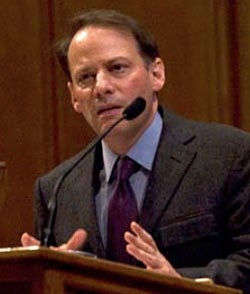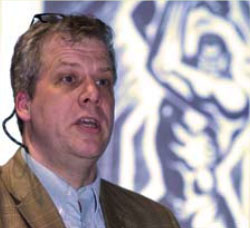Selected Remarks: Baker-Nord Distinguished Speakers 2008-2009
Unplugging at the Museum
During a visit to the Rock and Roll Hall of Fame and Museum last October, the New Yorker's Adam Gopnik gave an interview to Tom Mulready of CoolCleveland.com. His remarks echoed several themes from his Baker-Nord Center lecture, "What is the Museum For?"
I will tell you truly: I am against Acoustiguides. In my ideal museum, they would be banned. But in my ideal museum, wall labels would be, by force of arms, prohibited to a bare minimum. Because those are experiences we can get elsewhere.
We walk through our lives, at least I walk through mine, with my iPod on and my ear buds in my ear. I'm online, like everybody else, a good part of the day. What a museum, any kind of museum, offers you is an alternative to that experience. It offers you a different kind of an experience—an experience of the immediate confrontation between something very old, and usually handmade, and your own moment in time, your own sensibility, your own emotions now. And if we lose that as the essential experience of the museum, then it just becomes one more stop on the endless ribbon of entertainment that we're addicted to, in this country especially. And then there's no point to it. If we try and make museums more and more like all the rest of our experience, then we don’t need museums.
Museums occupy a different space, it seems to me, occupy a different moment in the making of our minds. And it's an important one. It's not necessarily better than all the other, plugged-in moments we have. But unplugging, in a culture as plugged in as ours, is a very important piece of our lives. And a museum is a place, I think, where you need primarily to unplug.
The Stories Archives Tell
Scott Reynolds Nelson, professor of history at the College of William and Mary, is the author of Steel Drivin' Man: John Henry, The Untold Story of an American Legend. Documents crucial to Nelson's research for the book came from the Western Reserve Historical Society, where he gave a public talk sponsored by the Baker-Nord Center and the Anisfield-Wolf Book Awards.
It's kind of a secret among historians, but entire books are often built around a single compelling source. That document, and the story it tells, can lead you to unravel all the histories that you thought you knew. Everything that seemed fixed or stable becomes unstable and strange. The vertiginous feeling that the world is very different than you thought it was is terrifying. But I got hooked on it, like a junkie. I discovered that the story I'd been taught about convicts and prisons and the South after the Civil War was just a story. It linked together well-known events in a coherent way. But I found that the story might be entirely wrong. I want to share with you some of that feeling—that roller coaster, holy smokes, oh my God feeling—that you get when you come across those kinds of documents.

Adam Gopnik
Photo: Robert Muller

Scott Reynolds Nelson
Photo: Robert Muller
